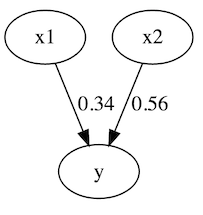I am trying to check if my implementation of backpropogation is correct by checking the calculated gradients with the numeric gradient.
I am testing it on a very simple linear network (i.e. no sigmoid on the output activation) as shown below:
There are two input neurons and one output neuron. The weights have the values [0.34, 0.56] and the bias is 0.54
The loss function used is the squared loss i.e.
$$ \frac{1}{2}(y - output)^2 $$
With an input of [1, 0], working out the gradients w.r.t the weights (dw) and bias (db) using the chain rule (backpropogation) gives me:
dw = [0.7744, 0] and db = [0.7744] which is exactly what my backprop implementation gives.
However, to calculate the numerical gradient my understanding is that I should compute $g(\theta) \approx \frac{J(\theta + \epsilon) - J(\theta - \epsilon)}{2\epsilon}$ where $J$ is the network output.
Using the example input of [1,0] and perturbing the 0.34 weight with $+/- \epsilon$ the numeric gradient will always be $1$, regardless of what I use for $\epsilon$. This is quite far away from my analytic gradient.
Am I doing something wrong?
Thanks

